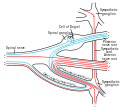General visceral efferent fiber
General Visceral Efferent Fiber
The general visceral efferent fibers (GVE fibers) are a type of nerve fiber that are part of the autonomic nervous system. These fibers are responsible for conveying motor impulses to the smooth muscles, cardiac muscles, and glands. They play a crucial role in the involuntary control of bodily functions such as heart rate, digestion, and respiratory rate.
Structure
General visceral efferent fibers originate from the central nervous system (CNS) and are part of the efferent division of the peripheral nervous system. These fibers are typically associated with the autonomic ganglia, where they synapse with postganglionic neurons that extend to the target organs.
The GVE fibers are divided into two main components based on their origin and function:
- **Sympathetic nervous system fibers**: These fibers originate from the thoracolumbar region of the spinal cord (T1 to L2) and are involved in the "fight or flight" response. They prepare the body for stressful situations by increasing heart rate, dilating airways, and inhibiting digestion.
- **Parasympathetic nervous system fibers**: These fibers originate from the brainstem and the sacral spinal cord (S2 to S4) and are involved in the "rest and digest" response. They promote relaxation and recovery by decreasing heart rate, constricting airways, and stimulating digestion.
Function
The primary function of general visceral efferent fibers is to regulate the activity of the visceral organs. They achieve this by:
- **Modulating cardiac function**: GVE fibers can increase or decrease the heart rate and force of contraction, depending on whether they are part of the sympathetic or parasympathetic system.
- **Controlling smooth muscle activity**: These fibers regulate the contraction and relaxation of smooth muscles in the gastrointestinal tract, respiratory system, and urogenital system.
- **Regulating glandular secretion**: GVE fibers influence the secretion of various glands, including salivary glands, sweat glands, and digestive glands.
Clinical Significance
Dysfunction of general visceral efferent fibers can lead to a variety of clinical conditions. For example, damage to the sympathetic fibers can result in Horner's syndrome, characterized by ptosis, miosis, and anhidrosis. On the other hand, parasympathetic dysfunction can lead to issues such as bradycardia or digestive disorders.
Understanding the role of GVE fibers is crucial in diagnosing and treating autonomic nervous system disorders. Medical interventions may include pharmacological agents that target specific receptors on the effector organs to modulate their activity.
Related Pages
- Autonomic nervous system
- Sympathetic nervous system
- Parasympathetic nervous system
- Efferent nerve fiber
- Visceral organ
General_visceral_efferent_fiber
Transform your life with W8MD's budget GLP-1 injections from $125.
W8MD offers a medical weight loss program to lose weight in Philadelphia. Our physician-supervised medical weight loss provides:
- Most insurances accepted or discounted self-pay rates. We will obtain insurance prior authorizations if needed.
- Generic GLP1 weight loss injections from $125 for the starting dose.
- Also offer prescription weight loss medications including Phentermine, Qsymia, Diethylpropion, Contrave etc.
NYC weight loss doctor appointments
Start your NYC weight loss journey today at our NYC medical weight loss and Philadelphia medical weight loss clinics.
- Call 718-946-5500 to lose weight in NYC or for medical weight loss in Philadelphia 215-676-2334.
- Tags:NYC medical weight loss, Philadelphia lose weight Zepbound NYC, Budget GLP1 weight loss injections, Wegovy Philadelphia, Wegovy NYC, Philadelphia medical weight loss, Brookly weight loss and Wegovy NYC
|
WikiMD's Wellness Encyclopedia |
| Let Food Be Thy Medicine Medicine Thy Food - Hippocrates |
Medical Disclaimer: WikiMD is not a substitute for professional medical advice. The information on WikiMD is provided as an information resource only, may be incorrect, outdated or misleading, and is not to be used or relied on for any diagnostic or treatment purposes. Please consult your health care provider before making any healthcare decisions or for guidance about a specific medical condition. WikiMD expressly disclaims responsibility, and shall have no liability, for any damages, loss, injury, or liability whatsoever suffered as a result of your reliance on the information contained in this site. By visiting this site you agree to the foregoing terms and conditions, which may from time to time be changed or supplemented by WikiMD. If you do not agree to the foregoing terms and conditions, you should not enter or use this site. See full disclaimer.
Credits:Most images are courtesy of Wikimedia commons, and templates, categories Wikipedia, licensed under CC BY SA or similar.
Translate this page: - East Asian
中文,
日本,
한국어,
South Asian
हिन्दी,
தமிழ்,
తెలుగు,
Urdu,
ಕನ್ನಡ,
Southeast Asian
Indonesian,
Vietnamese,
Thai,
မြန်မာဘာသာ,
বাংলা
European
español,
Deutsch,
français,
Greek,
português do Brasil,
polski,
română,
русский,
Nederlands,
norsk,
svenska,
suomi,
Italian
Middle Eastern & African
عربى,
Turkish,
Persian,
Hebrew,
Afrikaans,
isiZulu,
Kiswahili,
Other
Bulgarian,
Hungarian,
Czech,
Swedish,
മലയാളം,
मराठी,
ਪੰਜਾਬੀ,
ગુજરાતી,
Portuguese,
Ukrainian
Contributors: Prab R. Tumpati, MD




